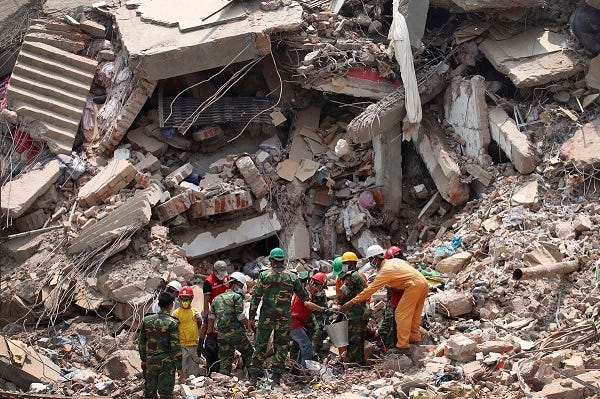Rana Plaza and Fast Fashion — What is it and why did it happen?
To get more articles like this straight to your inbox, subscribe to The Joy Thief newsletter.
April 24th marks the date of the horrific Rana Plaza collapse, where 1,134 people died, and over 2,500 were injured. This devastating incident is the deadliest garment factory accident to date. All for the sake of profit and fashion.

What was Rana Plaza?
Rana Plaza was a building that contained multiple clothing factories. Items were manufactured for the likes of Benetton, Bonmarché, The Children’s Place, Joe Fresh, Monsoon, Accessorize, Mango, Matalan, Primark, Walmart, and Zara. The lower portions of the building also contained shops, a bank, and some apartments. Sadly the building collapsed, killing and injuring many people.
What happened at Rana Plaza?
On April 23rd, 2013, attention was drawn to cracks in Rana Plaza, causing evacuation, closure and a warning to avoid the building. Owner, Sohel Rana, stated the building was safe to return to. Subsequently, factory owners threatened to withhold pay from workers who refused to return to work. Other units in the building remained closed and evacuated. The building collapsed the morning of April 24th, with over 3,000 people inside.

Local search and rescue team got to work, slowly recovering workers from the rubble. The UN offered support, which was declined by the Bangladesh government. Over 2,500 people were injured and, miraculously, a woman was rescued alive with few injuries, 17 days after the collapse! Unfortunately, 1,134 people died. There is often a disparity of genders in garment factories, resulting in over half the victims being female. However, there were nursery facilities in the building, and a number of children also died.

What caused the tragedy of the Rana Plaza collapse?
- According to the Bangladesh Fire Service & Civil Defense, the upper floors were built without a permit, and were structurally unsafe.
- The building’s architect stated that the building was designed for shops, and could not facilitate the weight and vibrations of factory machinery.
- Negligence of building owner, Sohel Rana. An instance of placing profits over the value of human safety and life.
- Lack of investment in regulating the safety of factories and working conditions within them.
- An element of corruption and conflicts of interest, which cause slow reforms. Many Bangladesh politicians are also factory owners, meaning progressive measures are not incentivised. Better safety and wages would incur expenses and increase costs for owners.
- Lack of diligence of retailers to monitor the capacity of their suppliers, safety standards and wages paid.
- Pressure from retailers on factories to deliver quickly and cheaply or risk losing business to competitors. Factories often risk short-cuts, rather than investing in safe working conditions, as seen with Rana Plaza.
- Lack of fair living wages which places pressure on workers. Pressure on factories to avoid losing business incentivised owners to undermine wages. The wages of workers at the time was approximately $35-$60 dollars a month. These wages are not considered sustainable, a fairer wage is suggested by some to be $100+.

Response and aftermath of the Rana Plaza collapse
- A case was filed against the building owner and the garment factories,with arrests issued. Sohel Rana was reported to have gone into hiding but was arrested after 4 days. Eventually, 18 people, including Sohel Rana, were charged for violating building codes at Rana Plaza.
- Thousands of workers protested for safer working conditions. Following protests and pressure, 18 garment plants were closed down due to safety precautions. Despite this, factory conditions, in many developing countries, continue to be unsafe and/or underpay workers. In conservative societies women, who account for the majority of garment workers, are not in a position to challenge working conditions. The True Cost, a documentary about fast fashion, shows that women are still at risk of unfair treatment, even when they form unions.
- A new Accord on Factory and Building Safety in Bangladesh was created. However, a number of high street retailers refused to sign it. In 2011, reforms that would have retailers pay more for apparel, to help Bangladesh factories improve safety standards, were also rejected. In 2013, some of these retailers announced a plan to improve factory safety in Bangladesh. However, unlike the Accord, the plan lacks legally binding commitments. It’s no surprise that factories, not only in Bangladesh, are still under pressure to deliver. Whilst there (thankfully) hasn’t been another Rana Plaza scale incident, accidents do still occur. Drastic industrial improvements are still lacking.
- Following the Rana Plaza collapse, protests took place outside some of the named and shamed retailers. Global consumers continue to express their anger at the lack of responsibility of retailers. Some have spoken out against the abuse of human rights within fashion. Today, we see people remembering the tragedy through Fashion Revolution, an organisation which hopes to revolutionise the fashion industry. Their campaign #WhoMadeMyClothes, allows consumers to collectively question transparency in social responsibility of supply chains, and call for sustainable improvements. It is also a chance for fashion brands, sustainable or otherwise, to show what they have improved in the industry.

High street fashion leads us down these deadly lines, where people, largely women, are forced to labour in unsafe conditions, for unfair pay.
The True Cost documentary has the eye-opening ability to demonstrate the horrific impacts of fashion on people and earth. It also highlights the lack of intersectionality in western feminism, where women empower themselves through an industry that enslaves others. While I used to buy new clothing every month from high street retailers, such is its impacts that my habits have completely changed. Due to the facts in The True Cost, I have since only bought one new item (from a sustainable brand) and a few thrifted items.
I implore you to see it, if you haven’t already, and start asking: Who Made My Clothes?

Want to know more about the fast fashion industry and how you can change it?
- Sign this petition to protect workers from unsafe working conditions and human rights violations.
- Visit Clean Clothes Campaign.
- Visit Fashion Revolution.
